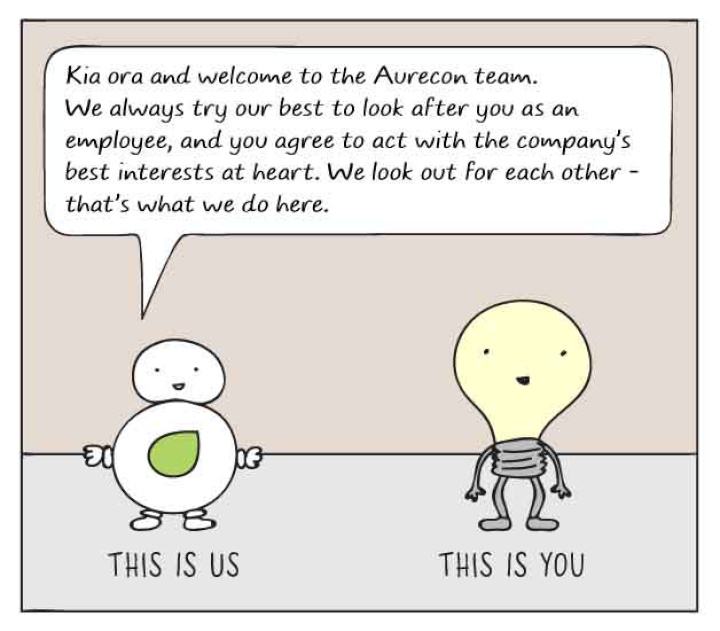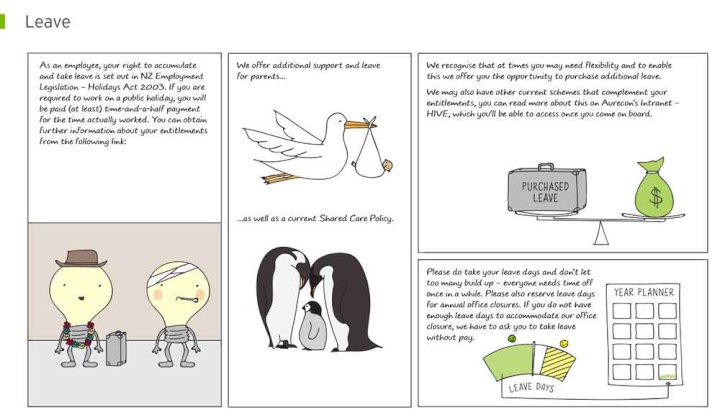New Zealand’s first visual employment contracts launched
28 September 2018
New
Zealand’s first visual employment contracts
launched
Global engineering and infrastructure advisory company, Aurecon will be the first company in New Zealand to use a visual employment contract, eliminating more than 5,500 words from their employment contracts to create a succinct and meaningful visual contract that uses illustrations to complement the text.


Leave arrangements
depicted in one of Aurecon’s Visual Employment
Contracts.
Developed in partnership
with Law Professor Camilla Andersen from the University of
Western Australia, Aurecon’s employment contracts are
legally binding contracts in which Aurecon and its employees
are represented by characters - free of legal jargon and
akin to a comic strip format.
“Aurecon is the first company in Australia and New Zealand to do anything like this, and globally this is the first time a visual employment contract has been focused at all levels of an organisation in a commercial context,” said Professor Camilla Andersen
With workplace polls often indicating a lack of meaningful employee engagement and trust, according to Aurecon’s Regional Director – New Zealand Carl Devereux, “the issue of engaging our talent and building their trust is becoming one of the biggest competitive differentiators across many industries and companies”.
Ranked Australia and New Zealand’s 5th most innovative company in 2017*, Aurecon also decided to use the employment contract as an exemplar of thinking innovatively as part of its focus on shaping the future of work.
“We looked at the employment contract and reimagined and reframed it to be meaningful,” says Carl Devereux.
“We also saw the Visual Contract as a way to demonstrate to our staff and new hires the culture we are seeking to build, particularly around two of our Aurecon Principles: Make the complex simple and Be playful with serious intent.”
“What better place to start meaningful engagement than when people are hired,” he said.
“Aurecon is a New Zealand firm operating across Australia, New Zealand, Asia, South Africa and the Middle East, with a culturally diverse workforce. Meaning can often be lost between offices, countries, cultures, and languages.”
“We should live in a world where contracts are written in accessible language — where people truly understand and feel comfortable signing an employment contract. A world where relationships are set-up to succeed by aligning expectations and developing the right culture at the outset.”
“Too often, contracts are too complicated for their own good. Those who develop the agreement often lose sight of the original purpose.”
“We also expect these contracts will lead to easier on-boarding, and a more open and transparent employee relationship,” says Devereux.
The rise of
visual contracts
Around
the world, a small but growing group of businesses, lawyers
and academics are rethinking contract design, using mind
maps, interactive mediums, images, and illustrations –
even contracts in a visual comic strip form.
Since launching the initiative in New Zealand in August 2018, more than 70 new employees have signed Aurecon’s new visual contracts in New Zealand. This new engagement model has also been rolled out by Aurecon in Australia and Africa. By the end of 2018, the company expects to have 1,200 employees signed-up on the new visual contracts.
With words like “severability”, and “contemporaneous”; and phrases such as “cumulative covenants”, “breach of duty”, “waive any moral rights” and “execute all instruments” – it is easy to see that traditional employment contracts are unnecessarily complex and don’t create an environment in which employment relationships can thrive.
New employees joining Aurecon in New Zealand no longer receive a Letter of Appointment accompanied by a lengthy Conditions of Employment document written in legal terms and small font.
By transitioning the employment contract into a visual contract format Aurecon has been able to not only dramatically reduce the number of words, more importantly, improve understanding with the removal of legalese and use of illustrations to explain concepts. They are also looking to extend this approach to Aurecon’s company policies.
But are they
enforceable?
Lawyers will
define a contract as something that is legally binding,
which can be taken to a tribunal or court and they will
reinforce a certain right.
“We strongly believe that there is no reason why a contract like this can’t be equally enforceable simply because there are pictures and simple language instead of detailed legal terms – although, until we actually have such a contract enforced in a court somewhere we can’t know for sure,” said Professor Camilla Andersen.
Our New Zealand legal advice has been that all legal requirements are met in the new visual contracts. A new employee signs in the spirit of the contract which is less descriptive and based more on trust and relationship building.
Working with Professor Andersen, Aurecon will complete a detailed assessment of the impact of the new contract later this year.
Visual contracts are an emerging discipline and part of a broader movement to simplify the law. “Ultimately, we all want the same thing – agreement, alignment and engagement. How we get there needs to be reimagined. The business world today can be overwhelmingly complex but our solutions, in the face of this complexity, need to stay simple,” says Devereux.
ends


 John Mazenier: Gaffer Tape And Glue Delivering New Zealand’s Mission Critical Services
John Mazenier: Gaffer Tape And Glue Delivering New Zealand’s Mission Critical Services Earthquake Commission: Ivan Skinner Award Winner Inspired By Real-life Earthquake Experience
Earthquake Commission: Ivan Skinner Award Winner Inspired By Real-life Earthquake Experience Reserve Bank: Consultation Opens On A Digital Currency For New Zealand
Reserve Bank: Consultation Opens On A Digital Currency For New Zealand NIWA: Ship Anchors May Cause Extensive And Long-lasting Damage To The Seafloor, According To New Research
NIWA: Ship Anchors May Cause Extensive And Long-lasting Damage To The Seafloor, According To New Research New Zealand Customs Service: A Step Forward For Simpler Trade Between New Zealand And Singapore
New Zealand Customs Service: A Step Forward For Simpler Trade Between New Zealand And Singapore Horizon Research: 68% Say Make Banks Offer Fraud Protection
Horizon Research: 68% Say Make Banks Offer Fraud Protection



